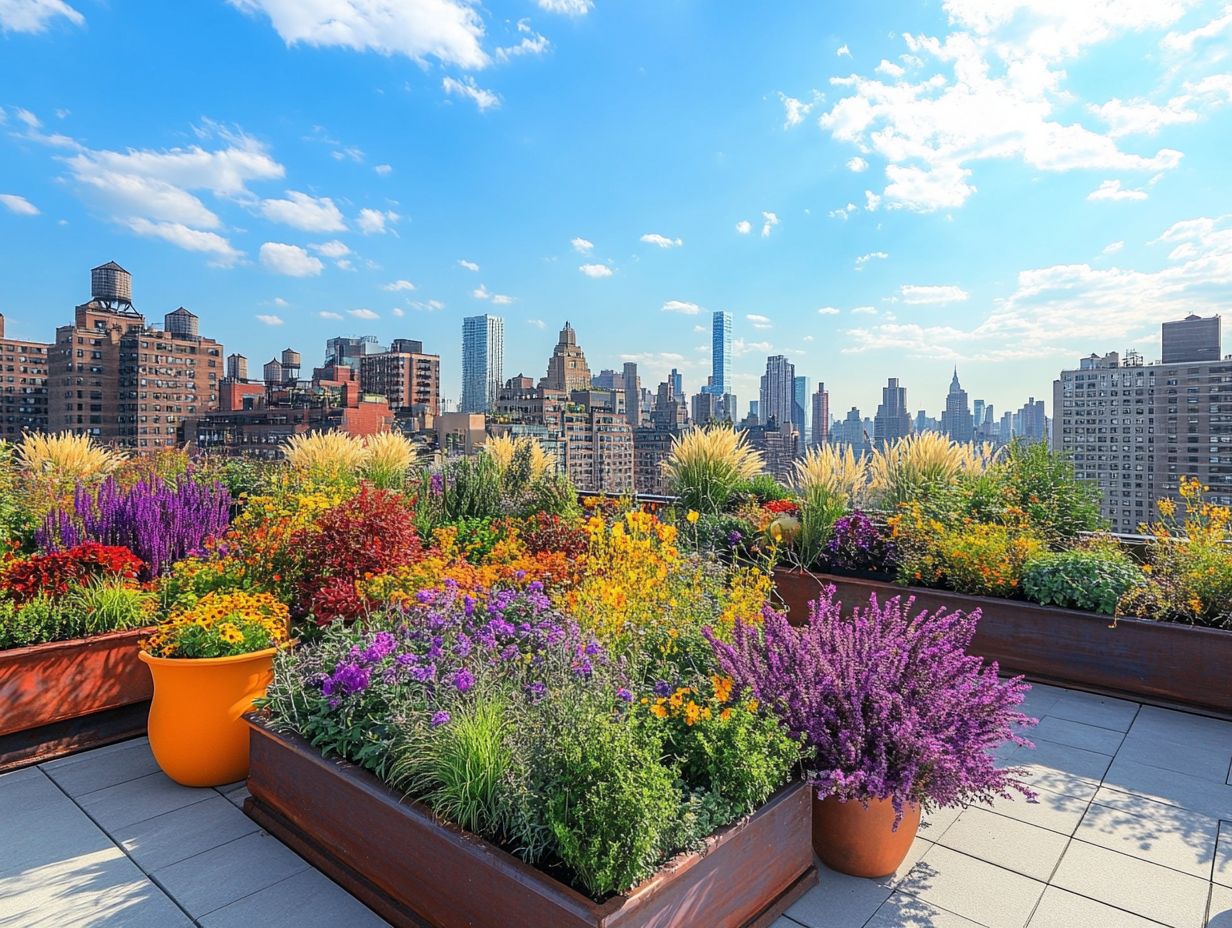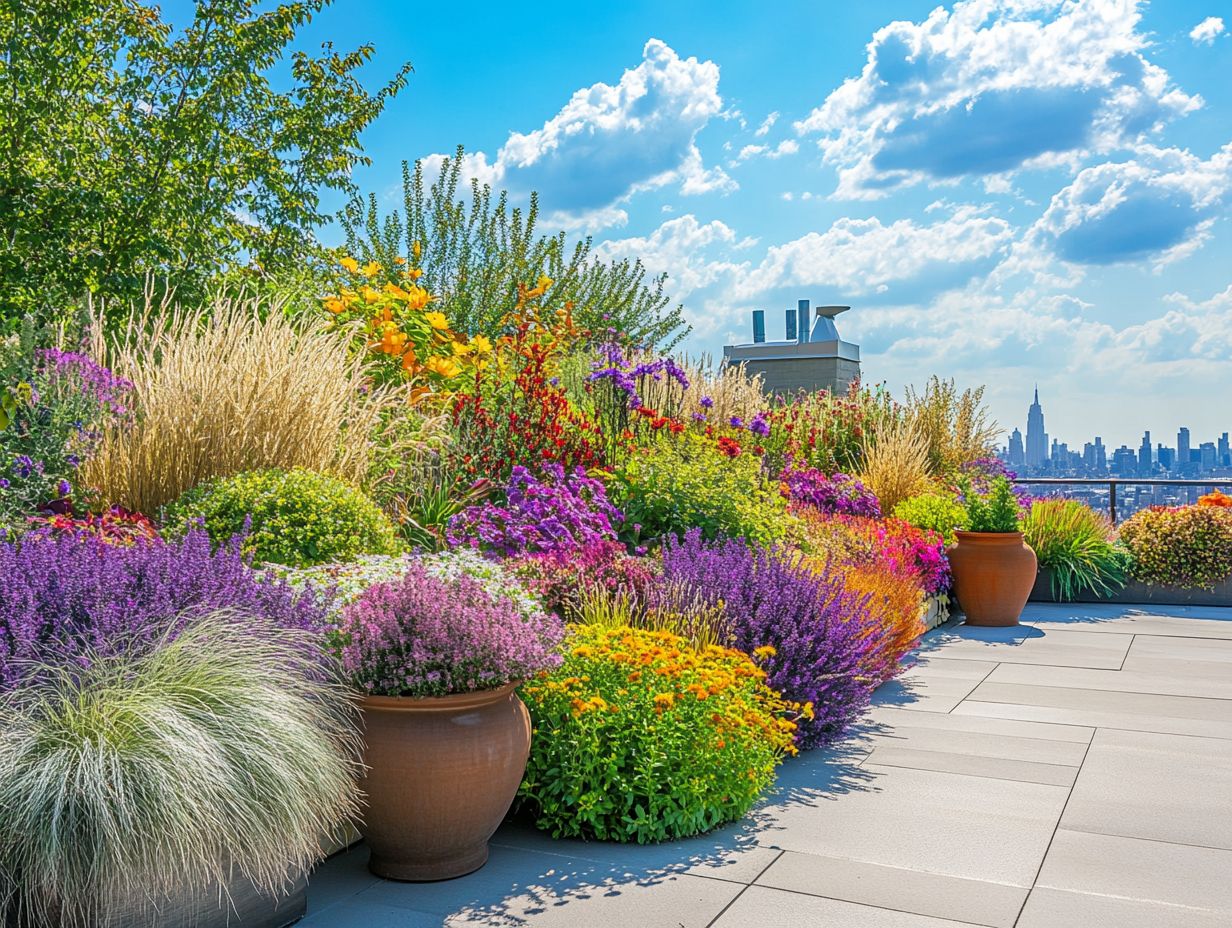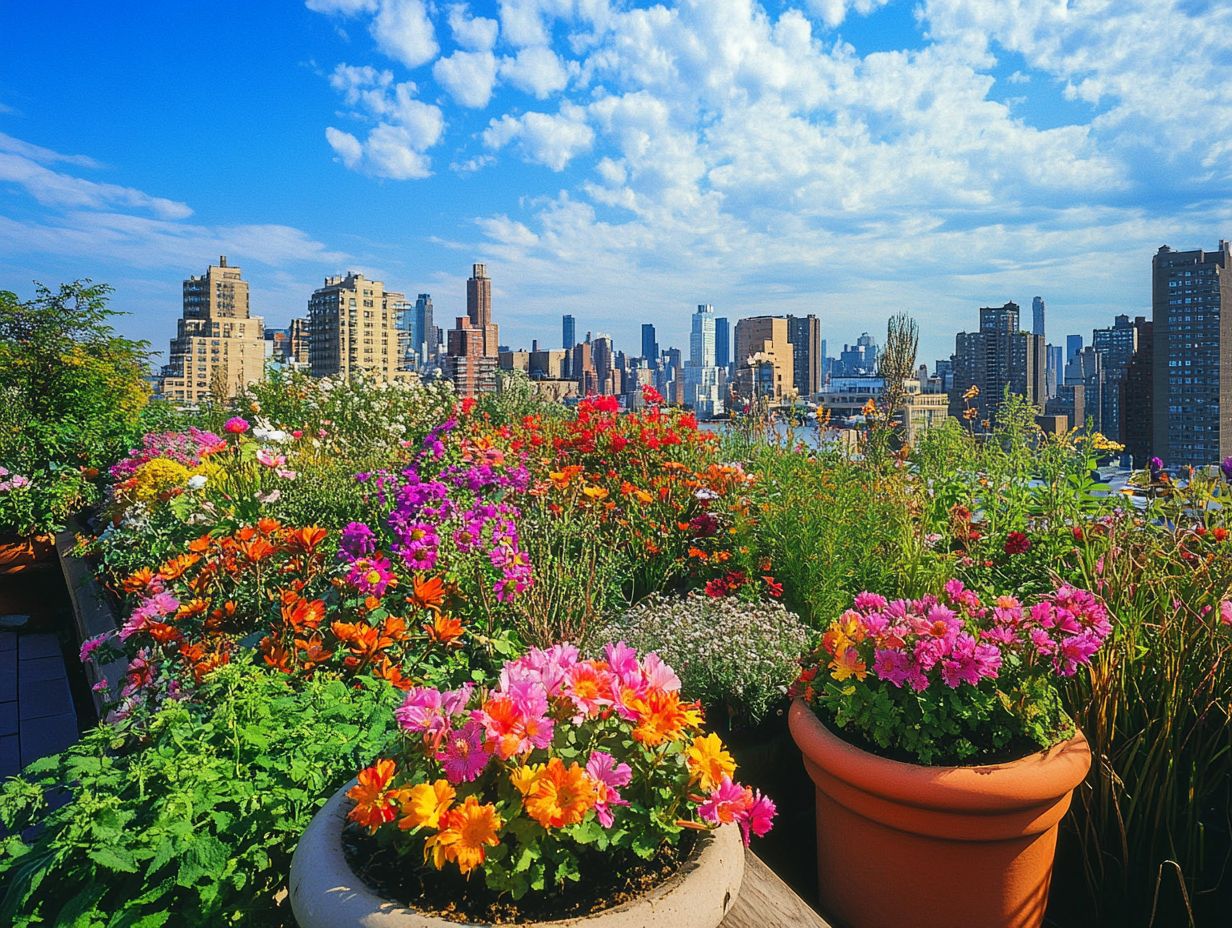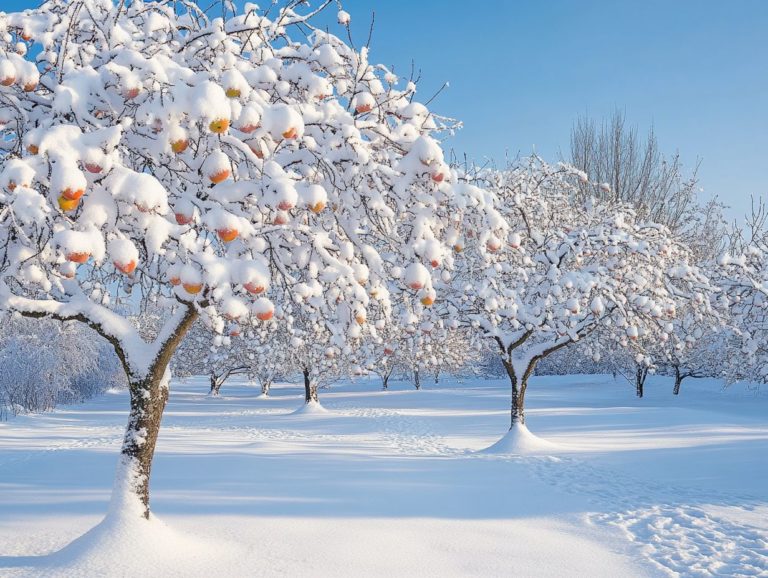Best Plants for Cold-Climate Rooftop Gardens
Creating a rooftop garden in a cold climate may seem daunting, yet it is an endeavor filled with potential and beauty, especially when incorporating diverse rooftop plants.
Let s dive into the unique challenges and discover how to overcome them! This guide provides valuable insights on plant selection, particularly for herbaceous and climbing plants, as well as preparation and maintenance.
From the top five plants that thrive in these conditions, including options for vegetable gardening, to effective strategies for extending your growing season, we provide guidance at every stage.
Discover how to design a vibrant rooftop garden that incorporates shade gardening techniques, not only withstanding harsh winters but flourishing throughout the year.
Transform your rooftop into a lush, green retreat that serves as your personal oasis, using fiberglass planters for better drainage.
Contents
- Key Takeaways:
- 1. Understanding the Challenges of Cold-Climate Rooftop Gardens
- 2. Factors to Consider When Choosing Plants
- 3. Top 5 Plants for Cold-Climate Rooftop Gardens
- 4. How to Prepare Your Rooftop for Planting
- 5. Tips for Maintaining a Cold-Climate Rooftop Garden
- 6. Benefits of Having a Rooftop Garden in a Cold Climate
- 7. How to Extend the Growing Season in a Cold-Climate Rooftop Garden
- 8. Common Pests and Diseases in Cold-Climate Rooftop Gardens
- 9. Choosing the Right Containers for Your Plants
- 10. Incorporating Edible Plants into Your Cold-Climate Rooftop Garden
- 11. Using Vertical Gardening Techniques in a Cold-Climate Rooftop Garden
- 12. How to Protect Your Plants from Harsh Winter Conditions
- 13. Creative Design Ideas for Cold-Climate Rooftop Gardens
- 14. Common Mistakes to Avoid in Cold-Climate Rooftop Gardening
- Frequently Asked Questions
- What are the best plants for a cold-climate rooftop garden?
- Can I grow vegetables in a cold-climate rooftop garden?
- Do I need to provide special care for plants in a cold-climate rooftop garden?
- Are there any low-maintenance options for a cold-climate rooftop garden?
- Can I add a variety of plant types in a cold-climate rooftop garden?
- Do I need to take any precautions to protect my rooftop garden from harsh winter weather?
Key Takeaways:
- Choose cold-hardy plants for rooftop gardens in harsh climates to ensure survival and growth while enhancing your urban gardening experience.
- Proper preparation, maintenance, and protection are key for a successful cold-climate rooftop garden, especially in managing drainage issues.
- Incorporate creative design ideas, extend the growing season using innovative planting solutions, and apply vertical gardening techniques to maximize space and benefits in a cold-climate rooftop garden.
1. Understanding the Challenges of Cold-Climate Rooftop Gardens
Cold-climate rooftop gardens present a unique set of challenges that demand custom approaches to ensure the health and productivity of your rooftop plants. For instance, selecting plants for cold climate community gardens requires special attention to aspects like plant care, soil types, and drainage issues, as these factors can significantly impact growth and sustainability.
In these gardens, you ll face significant temperature fluctuations that can affect root health and overall plant vitality. This situation calls for innovative planting solutions that promote resilience. With the limited sunlight typical of northern climates, your selection of viable plant species, especially climbing and herbaceous plants, will be restricted. Therefore, it s essential to choose varieties that can thrive under such conditions.
Soil drainage is another critical factor. You ll need a well-structured substrate to prevent the waterlogging that often plagues rooftops. By addressing these challenges through meticulous planning, you can create vibrant green spaces while positively contributing to urban environments, enhancing biodiversity the variety of plant and animal life in a particular habitat and improving air quality.
2. Factors to Consider When Choosing Plants
When selecting plants for your cold-climate rooftop garden, it’s crucial to consider various factors, including plant selection, container choices, and the unique challenges of nurturing healthy growth in confined spaces.
Opting for hardy species that can endure freezing temperatures and fluctuating conditions will significantly boost the odds of cultivating a thriving garden. Choosing the right containers is equally important; containers that offer optimal drainage are essential since excess moisture can lead to root rot, particularly during the cooler months. Those designed to retain nutrients not only support plant health but also minimize the need for frequent fertilization, fostering a more sustainable approach.
Regular maintenance, such as pruning and vigilant pest monitoring, is vital. This not only helps preserve the diversity of your garden but also contributes to a resilient ecosystem on your rooftop.
Start planning your rooftop garden today and transform your space into a green sanctuary!
3. Top 5 Plants for Cold-Climate Rooftop Gardens
Selecting the right plants is essential for your cold-climate rooftop garden’s success. The top five recommended plants include a delightful mix of herbaceous, woody, and climbing varieties that can thrive even under challenging conditions. For more options, check out the best vertical garden plants for cold climates.
Experts like Viveka Neveln and David McKinney highlight how adaptable these plants are to temperature fluctuations. They also enhance the visual allure of urban spaces. For instance, by choosing resilient species like Harry Lauders Walking Stick and Hosta that can endure harsh winters, your garden can remain vibrant throughout the year.
Maintenance requirements will vary. Some plants may demand minimal care, while others provide opportunities for seasonal pruning.
This thoughtful balance of resilience and beauty enables you to craft stunning rooftop landscapes, transforming cold climates into lush green havens.
4. How to Prepare Your Rooftop for Planting
Preparing your rooftop for planting requires you to consider various soil types, tackle potential drainage issues, and select the right rooftop planters that elevate your urban gardening experience.
Start by assessing the existing conditions of your rooftop. Pay attention to weight limitations and sunlight exposure. Once you have a clear picture of these factors, choose soil that s perfect for container gardening. You might blend a lightweight potting mix with compost to ensure your plants get the nutrition they need without stressing the structure.
Integrating a proper drainage system prevents water buildup. This protects your rooftop from damage. Establishing a stable foundation for your planters is vital; this stability supports healthy plant growth and contributes to a vibrant green oasis in the heart of the city.
5. Tips for Maintaining a Cold-Climate Rooftop Garden

Maintaining a cold-climate rooftop garden demands your consistent attention to plant care, tackling drainage concerns, and ensuring your container plants receive the necessary nutrients throughout the growing season.
Regular tasks like watering, fertilizing, and pruning are vital for keeping your plants thriving. Be vigilant about monitoring drainage to avoid waterlogging, which can lead to root rot.
As the seasons shift, adjusting your care strategies becomes paramount. For example, scale back on watering during the colder months or provide extra insulation for delicate plants, particularly herbaceous ones, to greatly influence their overall health.
Fertilize regularly to keep your soil nutrient-rich, enabling your plants to flourish amid the challenges typical of colder climates.
6. Benefits of Having a Rooftop Garden in a Cold Climate
Having a rooftop garden in a cold climate presents numerous environmental benefits that you won t want to overlook. Imagine improved air quality, a boost in plant diversity, and the chance to develop green roofs that beautify the urban landscape while mitigating the extra heat created in cities.
These lush green spaces play a crucial role in stormwater management, absorbing rainwater and reducing runoff. This helps alleviate the strain on municipal drainage systems, which manage rainwater in cities, making you a champion of urban sustainability.
Rooftop gardens also improve energy efficiency by providing natural insulation for buildings, helping you regulate indoor temperatures and ultimately lowering your heating and cooling costs.
But it doesn t stop there. These gardens foster biodiversity, attracting vital pollinators like bees and butterflies to urban areas and creating habitats for various species. By embracing these green spaces in your city living, you re contributing to a more sustainable ecosystem, promoting a healthier atmosphere and significantly enhancing your overall quality of life.
Start your cold-climate rooftop garden today and enjoy the benefits of green living!
7. How to Extend the Growing Season in a Cold-Climate Rooftop Garden
Extending the growing season in your cold-climate rooftop garden involves a range of strategic techniques that elevate plant care. Embrace container gardening methods. Select climbing plants and tackle any drainage issues head-on to enhance your garden s performance.
To navigate the unique challenges of urban rooftop environments, utilize row covers effectively. These protective barriers shield your plants from cold winds and frost, allowing them to flourish for extended periods. Incorporating heavy materials, such as rocks or water barrels, can also work wonders. They help retain heat during chilly nights and create a stable microclimate that encourages growth.
Choosing the right plants is crucial. Opt for those that can withstand cooler temperatures or mature quickly. Timing your plantings according to local frost dates and implementing staggered harvesting strategies can significantly boost your productivity. This way, you’ll ensure that every precious growing day is maximized for a bountiful yield.
8. Common Pests and Diseases in Cold-Climate Rooftop Gardens
Cold-climate rooftop gardens, while offering their own set of unique challenges, still encounter the usual suspects when it comes to pests and diseases. To thrive, choosing plants for cold-climate containers is essential, along with embracing proactive plant maintenance and effective urban gardening strategies.
These gardens, often ingeniously designed to make the most of limited space, can attract pests like aphids, spider mites, and whiteflies. These pesky intruders can wreak havoc on plant growth and overall garden productivity. On top of that, diseases such as powdery mildew and root rot find a welcome home in the confined, sometimes humid conditions typical of rooftops.
To tackle these issues head-on, consider implementing a few preventive measures in your urban gardening strategy:
- Regular inspections of your plants and soil conditions
- Companion planting methods, including pairing certain plant species to deter pests
- Utilizing organic pesticides when necessary
Act now regularly inspecting your plants keeps them healthy and prevents pest problems before they start! Additionally, fostering good airflow and ensuring proper drainage will go a long way in mitigating disease risks. By taking these steps, you can keep your plants healthy and productive throughout the growing season.
9. Choosing the Right Containers for Your Plants
Choosing the right containers for your plants is crucial in container gardening, especially in cold-climate rooftop gardens, where drainage issues and nutrient retention are paramount for plant health.
The type of container you select can significantly impact growing conditions. Fiberglass planters have become a favored option thanks to their remarkable durability and versatility. These lightweight yet robust containers not only withstand temperature fluctuations but also excel in moisture retention.
Ensuring proper drainage is essential. Opting for containers with drainage holes will help prevent overwatering and promote healthier roots. Additionally, adopting nutrient management strategies like utilizing high-quality potting mixes or organic fertilizers can significantly support robust plant growth.
By understanding the advantages of various container types and implementing effective practices, you can cultivate thriving green spaces, even in challenging climates.
10. Incorporating Edible Plants into Your Cold-Climate Rooftop Garden

Incorporating edible plants into your cold-climate rooftop garden not only elevates your culinary options but also enriches your gardening experience. For those interested in enhancing their garden, choosing plants for a cold-climate rock garden presents rewarding challenges in vegetable gardening and plant care.
Imagine the crisp flavors of kale and Swiss chard mingling with the vibrant bursts of hardy herbs like thyme and parsley all thriving in those cooler temperatures. By cultivating these plants, you can explore a bounty of nutritious produce right at home, adding a fresh, organic touch to your meals.
Adding edible plants enhances your urban gardening efforts, providing a sustainable source of food while helping you minimize your carbon footprint.
11. Using Vertical Gardening Techniques in a Cold-Climate Rooftop Garden
Vertical gardening techniques offer remarkable advantages for cold-climate rooftop gardens. They enable you to make the most of limited space while enhancing plant care. These methods allow for the incorporation of climbing plants that flourish in urban environments.
By employing structures like trellises and wall planters, you can reimagine underutilized areas into lush green escapes. These not only elevate the aesthetic appeal but also optimize airflow and sunlight. This strategy maximizes vertical space and introduces captivating visual interest, softening the harsh lines of urban architecture.
Your vertical systems can support a diverse array of plants. From vibrant flowering vines to homegrown vegetables, they provide a rewarding way to indulge in gardening above the bustling city streets.
Transform your rooftop with these exciting elements! They encourage sustainable practices and promote biodiversity, enhancing air quality within urban settings.
12. How to Protect Your Plants from Harsh Winter Conditions
Protecting your plants from harsh winter conditions is crucial for the sustainability of cold-climate rooftop gardens. Consider choosing the right plants for cold climates, as it requires thoughtful care and strategies to address drainage issues and temperature extremes.
By taking proactive measures, you can cultivate an environment that nurtures your plant selections through the colder months. Insulating your containers is a key step. Utilizing materials like burlap or foam can help retain soil warmth and prevent freezing.
Choosing hardy plants, such as evergreens or perennials, ensures vibrant greenery even in the depths of winter. For those interested in creating a beautiful space, utilizing the best plants for cold-climate wildflower gardens can make a significant difference. Using protective coverings like frost blankets or winter wraps shields your plants from frost and reduces snow accumulation. This allows your rooftop garden to flourish despite the chill.
13. Creative Design Ideas for Cold-Climate Rooftop Gardens
Creative design ideas for cold-climate rooftop gardens can elevate your space into a vibrant oasis. They showcase plant diversity while addressing the unique challenges of urban gardening, particularly when it comes to selecting plants for cold-climate rain gardens.
By incorporating innovative concepts such as tiered planter boxes and vertical gardens, you can maximize limited space. This optimizes drainage and sunlight exposure for a variety of plants.
Utilizing hardy species like ornamental grasses, succulents, and perennials enhances the aesthetic appeal. It also guarantees year-round greenery.
Pairing contrasting colors and textures, along with thoughtful container arrangements, invites a dynamically visual experience. This transforms with the seasons, elevating the overall ambiance and encouraging biodiversity. You can turn your rooftop garden into a tranquil escape, where you can unwind amidst nature.
14. Common Mistakes to Avoid in Cold-Climate Rooftop Gardening
Avoiding common mistakes in cold-climate rooftop gardening is vital for ensuring the success and longevity of your plants. This is especially important when it comes to maintenance and urban gardening strategies.
As a gardener in these regions, it s essential to consider crucial factors like proper insulation, good drainage, and selecting plants that can endure low temperatures. By recognizing these frequent pitfalls, you can make informed decisions that lead to a thriving outdoor space.
For example, opting for frost-tolerant varieties can make a world of difference. Ensuring adequate drainage will prevent the dreaded waterlogged roots that could spell disaster. By taking into account the microclimate of your rooftop, such as sunlight exposure and wind patterns, you can cultivate a resilient garden that not only survives but flourishes in even the harshest conditions.
Frequently Asked Questions
Here are some common questions about cold-climate rooftop gardening.

What are the best plants for a cold-climate rooftop garden?
Some great options for cold-climate rooftop gardens include sedums, hens and chicks, yarrow, echinacea, and ornamental grasses.
Can I grow vegetables in a cold-climate rooftop garden?
Yes, you can! Vegetables like kale, lettuce, and carrots are hardy enough to withstand cold temperatures and can thrive in a rooftop garden.
Do I need to provide special care for plants in a cold-climate rooftop garden?
Cold-climate plants are hardy. However, they still need care.
Regular watering, fertilizing, and occasional pruning help your plants thrive.
Are there any low-maintenance options for a cold-climate rooftop garden?
Yes, there are! Consider succulents, herbs like rosemary and thyme, and hardy shrubs like juniper and boxwood.
Can I add a variety of plant types in a cold-climate rooftop garden?
Mixing different plant types makes your rooftop garden visually appealing. It also creates a diverse ecosystem.
Just choose plants with similar sunlight and water needs.
Do I need to take any precautions to protect my rooftop garden from harsh winter weather?
Protect your rooftop garden from harsh winter weather! Strong winds, heavy snow, and frigid temperatures can harm your plants.
Install wind barriers, use mulch for insulation, and cover plants with burlap during severe weather.






